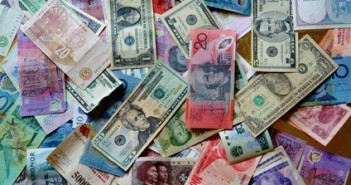Flight to safety was the theme of the day for European and Asian bourses as escalating tensions in Iraq and Ukraine led investors to take profit and seek refuge in safe assets, following in the footsteps of the Dow which had its biggest decline in a month despite the US posting better than expected new home sales and consumer confidence, falling 119.13 points to end at 16,818.13. German Chancellor, Angela Merkel, in a session of the Bundestag warned that further sanctions targeted at entire sectors of the Russian economy would be warranted should Russia not step up its efforts to reach a settlement with Ukraine. The Russian parliament, on its part, revoked its earlier decision to authorize President Vladimir Putin to deploy armed forces on Ukrainian territory.
The Asian session was led lower by materials as the lack of fundamental data had investors focusing on equities. The yen showed little reaction to Prime Minister Shinzo Abe’s latest installment of the “Third Arrow†to revitalize Japan through a series of new government policies to encourage business expansion following Abe’s assertion that the era of deflation has come to an end. The Liberal Democratic Party will seek to approve a law to legalize casinos as part of its plan to boost tourism ahead of the Tokyo Olympics in 2020.
Moving to Europe, the euro has retraced its losses and is trading at the intraday high of 1.3651 following weaker than expected US GDP data. The theme for the euro continues to be low and vulnerable growth amid a backdrop of inflation that could have bottomed out but is well contained and with a dovish central bank compared to its G4 peers where interest rate hikes are not expected before 2017, the euro is expected to weaken into year end. In economic data, GfK German Consumer Climate for May climbed to 8.9 points, beating estimates of 8.6 points and Italian retails sales also showed signs of improvement at 0.4% from March’s contraction of 0.2%.
The pound after reaching a 5 ½ year peak of 1.7064 last week has struggled to sustain those gains following the whipsaw in policy outlook delivered by Bank of England Governor Carney. In his testimony in front of the Treasury Select Committee yesterday, Carney said that there is still plenty of slack in the economy to work through – as evidenced in the inconsistency of weak wage growth and benign inflation, despite strong employment gains and solid economic expansion – and financial markets are underestimating the uncertainty that surround the UK economy. This dovish tilt in tone is inconsistent to Carney’s speech a month ago at the Mansion House where he hinted that interest rate hikes was on the radar for the central bank and highlights the divergence within the Monetary Policy Committee where top officials are doves while the rest of the committee are hawks following the overhaul of staff at the central bank.
Heading into the North American session, there will be a slew of fundamental data for markets to digest, beginning with the third revision to first quarter GDP, durable goods and personal consumption expenditure. The US economy contracted more than anticipated in the first quarter at -2.9%, and posted its steepest decline since early 2009 as consumer spending declined from 3% to 1%. Durable goods tumbled 1% in May with the decline directly attributed to slower demand in military equipment. Personal consumption expenditures for the first quarter came in line with expectations at 1.3%. Later in the morning we will see the release of Market service PMI and PMI composite for the month of June.
The Canadian dollar is strong this morning, benefitting from weak fundamental data from the US, and looks to test the 1.0708 which represents the 50% retracement level of the rally from 1.0137 to 1.1279. The recent strength of the loonie certainly brings to question, how much lower can USD/CAD go? Domestic data from both sides of the border has improved; the Federal Reserve has maintained a consistent tone. However in order for the loonie to strengthen further, we would need to witness a shift in tone from Bank of Canada Governor Poloz to a more neutral and hawkish tone. Typically, higher oil prices is CAD positive, however, the reason behind the recent hike in prices is attributed to geopolitical risk as opposed to demand for oil. Accordingly, the next Bank of Canada meeting slated for July 16 will be a key event for the pair of USD/CAD for further direction.
Further reading:
Canadian dollar
US GDP data



